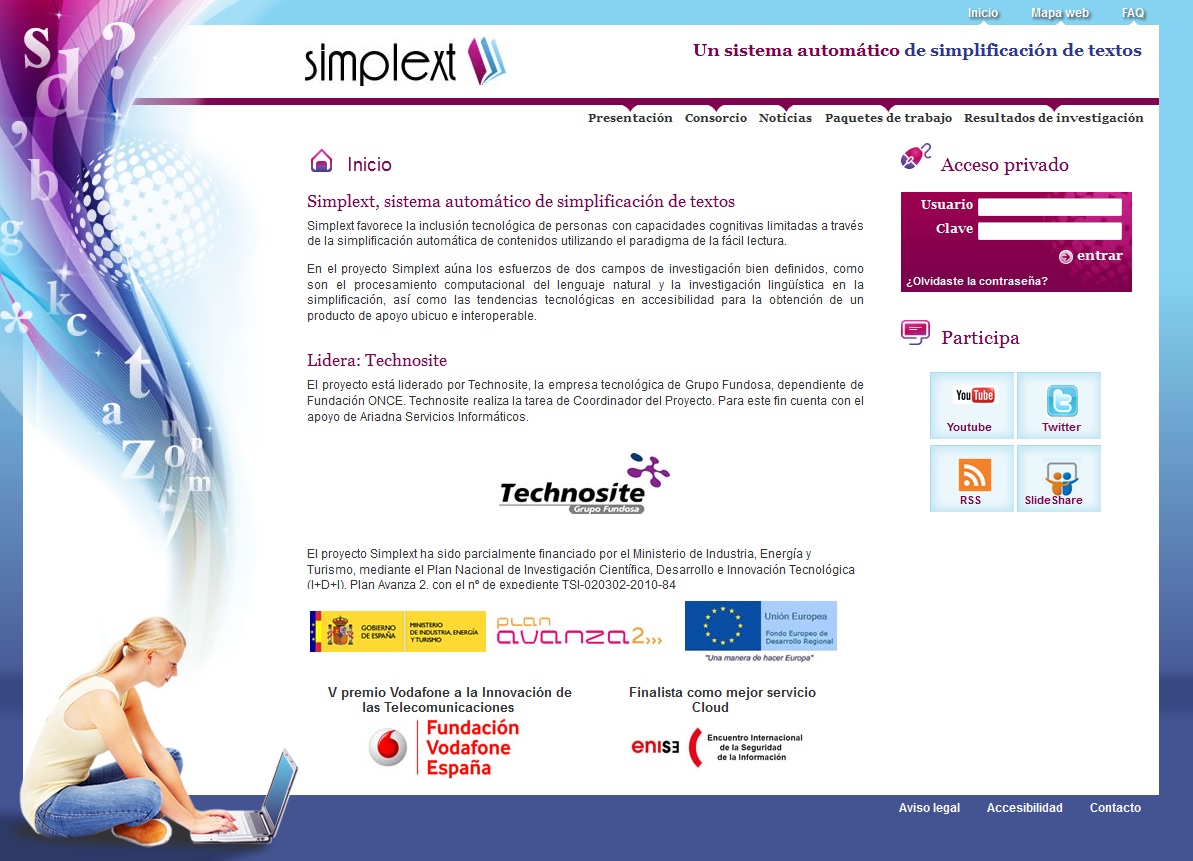SIMPLEXT, at the service of people with learning disabilities
SIMPLEXT, at the service of people with learning disabilities
 SIMPLEXT, a project coordinated by Horacio Saggion and undertaken by members of the Natural Language Processing Research Group, a group led by Leo Wanner, an ICREA researcher at the DTIC, is the first project to develop automatic simplification techniques for texts in Spanish in order to make reading for people with some types of learning disabilities, such as Down syndrome.
SIMPLEXT, a project coordinated by Horacio Saggion and undertaken by members of the Natural Language Processing Research Group, a group led by Leo Wanner, an ICREA researcher at the DTIC, is the first project to develop automatic simplification techniques for texts in Spanish in order to make reading for people with some types of learning disabilities, such as Down syndrome.
The project brings together two well-defined areas of research: first, the computational processing of natural language, and second linguistic research on text simplification. It also includes the most innovative technological trends in terms of user accessibility.
Simplifying and adapting a text is a transformation that is roughly equivalent to making it easier to understand for a specific group. Generally speaking, in the adapted texts the sentences are shorter, they do not have so many subordinations or coordinations, the vocabulary is simpler, difficult expressions are explained and the active voice is used instead of the passive whenever possible.
Recognized with several awards
Simpletx began in November 2010, and was promoted by Avanza (2010-2012), a plan of the Ministry of Industry, Tourism and Trade. Soon afterwards, in 2011, it received the Vodafone award for Innovation in Telecommunications. More recently, in late 2013, it was awarded the Telefónica Chair - University of Alicante prize for the best computer system applied to human language technologies in social inclusion and disability.
Simplifying means making something more easily understood by a specific group
Based on natural language processing
Natural language processing involves the interaction between computers and human and natural languages, and has its origins in artificial intelligence, at the point where computer science and linguistics converge.
The methodology adopted by Simpletx was based on natural language processing, using three main components: syntactic simplification, lexical simplification and a rewriting system. These three components, together with basic tools for analyzing text in Spanish, have been integrated into the Simpletx simplification and subsequently evaluated ini users.
 Aimed at people who have difficulty reading and writing
Aimed at people who have difficulty reading and writing
Simpletx is aimed at all those who have difficulty reading and writing in their own language. These difficulties may be due to various reasons, such as:
- Cognitive disabilities.
- Other disabilities that influence the ability to read or write.
- Limited education.
- Economic and social problems.
- Discordance between the subject's mother tongue and the language of the community in which they live.
SIMPLEXT és el primer sistema de simplificació en castellà adreçat a persones amb discapacitat intel·lectual
Main contributions of the project
Simpletx is the first simplification system in Spanish aimed at people with learning disabilities which has contributed to the study of text simplification and has proposed an evaluation method for simplification.
The project's evaluation method includes a readability index in Spanish, measures for evaluating the text's grammaticality and the preservation of meaning, and evaluation of reading comprehension.
It will continue as part of an international project
The technology developed by Simpletx will continue within a new project funded by the European Commission, the ABLE-TO-INCLUDE project, in which the UPF Natural Language Processing Research Group will participate.
Report published in upf.edu - number 7, February 2014
Photo: Frederic Camallonga
